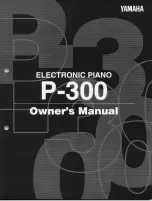
19
accurate sounds, and allows precise de-tuning. The Oscillator Slop parameter
allows subtle amounts of frequency drift. For larger amounts, use a random LFO
or white noise mod.
Pitch Wheel Range:
0…12 —
Sets the bend range, in semitones, of the pitch
wheel. The setting is the range in the positive or negative direction. For
example, a setting of 7 lets you bend a note up or down by a fifth.
Mixer Parameters
Osc Mix:
0...127 —
Enables the outputs of Oscillators 1 and 2 to be mixed in
varying amounts. A setting of 0 is equivalent to 100% Oscillator 1 and 0%
Oscillator 2. A setting of 127 is just the opposite. A setting of 64 is essentially a
50-50 mix of both oscillators.
Noise Level:
0…127 —
Controls the volume of white noise mixed into the
filter.
Feedback Parameters
Feedback Volume:
0...127 —
This controls the amount of audio from the left
channel of each voice fed back into that voice's mixer pre-filter. As the value
increases, so does the effect of the feedback.
Feedback Gain:
0…127
— Feedback Gain boosts the level of the feedback
signal and is interactive with and dependent upon Feedback Volume. If
Feedback Volume is set to 0, then Feedback Gain has no effect. (There is no
feedback signal to boost.) However, Feedback Gain combined with higher levels
of Feedback Volume can result in effects ranging from pleasing distortion to
squirrelly harmonic weirdness.
Low-pass Filter Parameters
Each of Tetra’s voices utilizes a switchable, 2- or 4-pole analog low-pass filter
coupled with a 4-stage (plus delay) ADSR envelope generator.
Frequency:
0…164 —
Sets the base filter cutoff frequency over more than 13
octaves. This control steps in semitones.
Resonance:
0…127 —
Sets the Resonance level of the filter. At high settings
the filter will self-oscillate in 4-pole mode. If the filter does not oscillate, switch
to 4-pole mode.
Keyboard Amount:
0…127 —
Sets the amount of keyboard (MIDI note) to the
filter cutoff. A setting of 64 will step the filter one semitone for each note, 32
would be half-semitones, and so on.











































